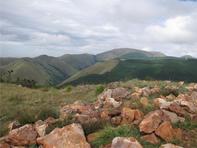Genesis of Life
Not many towns can boast that within their midst lies a World Heritage Site. Not only can Barberton proudly do that, it can also claim to have one of the world’s oldest geological outcrops: the Makhonjwa Mountain.

It is estimated that Makhonjwa Mountain has been in existence for approximately 3.6 to 3.25 billion years. This means that when complex life forms were emerging Makhonjwa Mountain was already present. Fossilised bacteria was found near Barberton dating back to around 3.2 billion years.
The Makhonjwa Mountain though one of the oldest rocks on earth is not the oldest rock on earth. However, it is the oldest suite of sedimentary rocks, which forms part of the first proto-continent that was formed from reprocessed minerals brought to the surface as the broiling planet sufficiently started to cool down to form a crust. This approximately occurred 3.3 to 3.4 billions years ago.
This suite of sedimentary rocks is known as the Barberton Greenstone Belt, of which the Makhonjwa Mountain makes up 40%. The world-renowned Barberton Greenstone Belt is a geological wonder made of ancient rock that is nearly 3.5 billion years old and is comprised of three primary rock groups, namely the Onverwacht Group, the Fig Group, and the Moodies Group.
Greenstone belts originate from multiple layers of volcanic and sedimentary rock. This blend of rock is named after the green minerals, of which it is comprised, such as actinolite, amphiboles, fuchsite, epidote, green chlorite and serpentine. The Greenstone Belt is also known as the Genesis of Life because its geological composition is made up of ancient Archaean rock.
If you find yourself in Barberton, a town known for its gold mining history, you will also be in the presence of the preserved geological past, as the Archaean period was one marked by the earth’s formation. This makes it a snapshot of ancient history, a glimpse into what our planet once looked like before industrialisation took place.
 The cultural heritage of the Mpumalanga province is both varied and exciting. The Ndebele beadwork and house painting in the north-west, the...
The cultural heritage of the Mpumalanga province is both varied and exciting. The Ndebele beadwork and house painting in the north-west, the...